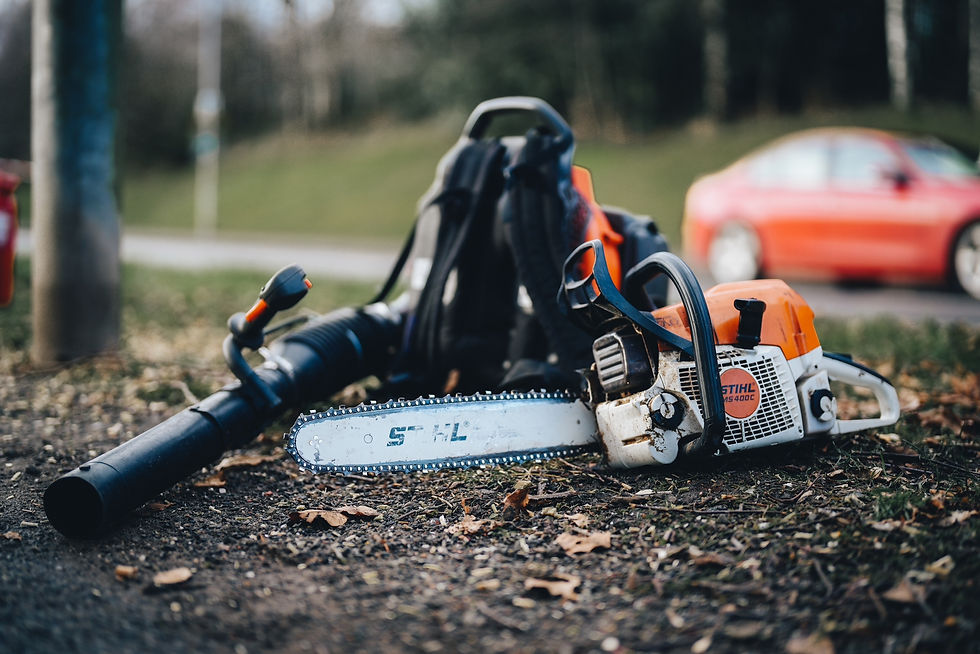What is Epicormic Growth?
- Neil Foote

- Jun 8, 2022
- 3 min read
You don't see it, but underneath Deciduous tree's bark are "Dormant Buds". These buds thoughout the growing season from March onwards, are slowly covered up by the trees new growth, and fresh dormant buds replace them towards the surface of the bark. This process of laying down fresh layers of buds over old, suppresses the buds and stops them from growing.

If the tree is damaged in some form, either a limb lost, mechanical damage by forestry machinery or disease these Dormant buds are activated by the tree as an insurance to survival. Lost or damaged limbs means there is less leaf coverage for the tree to Photosynthesis, which means less sugars available to the tree for sustenance.
The crown of the tree is always in "communication" with the root systems via hormones travelling through the Phloem (vascular living tissue) and to a lesser extent the Xylem. When the hormones reach a damaged part of a the tree, it causes the Dormant buds to begin to grow.
So Why is Epicormic growth a problem?

Epicormic growth isn't always a problem, in fact, humans have been using this natural occurrence for thousands of years in the form of "coppicing". The new growth was harvested for staves, basket weaving, fencing, thatched roof staples and animal fodder to name a few.
The problem with Epicormic growth in the Arboricultural industry is poorly pruned branches, can end up sprouting multiple shoots, which in time turn into branches, leaving home owners with 10 times the problem they started with. Even worse than this, the new branches are poorly attached to the parent branch, leaving weak "unions" which are more likely to fail and break off in windy conditions, or when the limb has reached a sufficient weight to simply sheer off. Giving a tree a "haircut" or simply chopping the tree in half may seem like a good idea in the short term, but will definitely come back to bite you in the long term.
How do we stop Epicormic growth becoming a problem?
When it comes to caring for peoples trees in their gardens there's many things a tree surgeon can do to limit epicormic growth. The first thing is to know the species of tree we're working with, understand that particular trees biology and know the best time of the year to prune. Certain Tree's are prone to high Epicormic activity, they include;
Lime Tree's (Tilia)
Willow (Salix)
Oak (Quercus)
Elm (Ulmus)
Correct pruning cuts are essential to reducing epicormic growth in trees. Large Branches and limbs should always be taken back to the branch collar where possible, the branch collar has the ability to grow over any wounds and compartmentalize any infections. When pruning branches, the length should be brought back to a lateral branch (branch growing sideways) that is no larger in diameter than 1/3rd of the branch being taken off. This will allow the lateral to take over the role of the original branch and not sprout new epi growth.
"Lions Tailing" should always be avoided at all costs. This is where the branch is cut along it's length with no consideration for a lateral. Once the epicormic growth sprouts from the end of the branch it looks exactly like a Lions Tale!

In defense of Epicormic Growth
Having gone over a lot negative points when it comes to Epi growth, let's look at it from a trees perspective. Epicormic growth is a tree's short term solution to a threat to it's survival. The growth that occurs takes very little energy away from the tree, and allows the tree to both regrow and thus start photosynthesizing again but also compartmentalize the wound that has occurred to a certain extent. Although the unions of the branches are weak, if they break off the tree can simply start again with very little effort.
Tilia (Lime) is prolific when it comes to Epicormic Growth. It's not unusual to see a Lime in the City or Town with a min forest erupting from its base. If you have Epicormic growth on your tree you can prune it, the same way as you'd make any pruning cut, ideally with secateurs and keeping close to the base of the growth. Don't attempt to Chainsaw shoots, as this can stress the Cambium layer of the tree and lead to increased growth.
If you're unsure as to the health of your tree after reading this article, then give us a call. We love nothing more than meeting people in their gardens and talking to them about the best way to care for their tree. Even better, we offer a free no obligation quote, so you don't have to pay for our years of experience in the first instance.

.png)


Comments